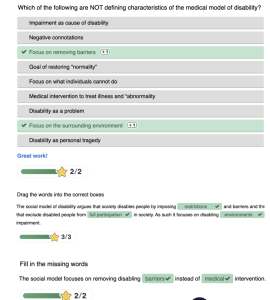5
Section one: The fundamentals
A)
Exercise 1: Notebook Prompt
Many of you are likely familiar with the concept of “ability inequity,” which the authors of this article define as “an unjust or unfair (a) ‘distribution of access to and protection from abilities generated through human interventions’ or (b) ‘judgment of abilities intrinsic to biological structures such as the human body’.”
However, they go on to identify the following “ability concepts” that are less familiar:
1) ability security (one is able to live a decent life with whatever set of abilities one has)
2) ability identity security (to be able to be at ease with ones abilities)
How prevalent are these forms of security among disabled people you know? Or, if you identify as a disabled person, would you say your social surroundings and community foster and support these kinds of security? Furthermore, while the focus of the article is on Kinesiology programs, it is also important to reflect on how academia in general accommodates for disability. If you feel comfortable answering this question, what has been your experience of postsecondary education to date?
-OR-
The authors also observe that “Ableism not only intersects with other forms of oppression, such as racism, sexism, ageism, and classism, but abilities are often used to justify such negative ‘isms’.”
What do you think this means? Provide an example.
|
I think the author means that it doesn’t exist in isolation and that it can be often intertwined with other forms of oppression such as with racism, sexism, ageism, and classism. Society can often use ideas about ability to excuse their other forms of oppression. An example of this is with women being labeled too emotional and are weaker than men. This relates to this perceived ability becomes the rationale for the unfair treatment their facing.
|
Exercise 2: Implicit Bias Test
Did anything surprise you about the results of the test? Please share if you’re comfortable OR comment on the usefulness of these kinds of tests more generally.
| I got 14% which was no or little preference to able-bodied individuals over disabled individuals. I was not suprised by the results as I didn’t believe I had a bias over one of the other. The test is useful with having self-awareness and understanding if you do have a potential bias and can help in being the first step in addressing these biases and attitudes.
|
B) Keywords
Exercise 3:
Add the keyword you contributed to padlet and briefly (50 words max) explain its importance to you.
| Medical model of disability. These keyword stood out to me right away as in understanding it as it views disability as a problem located within the individual and is caused by a potenial medical condition or illness or injury. According to this model, it’s focus is on treating this disability and allow for the person function like a normal person in society.
|
B) On Disability
Exercise 4: Complete the Activities

Exercise 5: Notebook Prompt
What do Fitzgerald and Long identify as barriers to inclusion and how might these apply to sport in particular?
Fitzgerald and Long identify many different barriers to inclusion such as Attitudinal barriers which relate to negative stereotypes about the capabilities of disabled people can lead to them being neglected from sports. People can and may underestimate their abilities and limit them from potential opportunities. Another barrier is economic barriers which has to do with costs of equipment disabled people may need in order to participate and many facilities are not designed with accessibility in mind. Not having certain equipment can make it even more difficult for these individuals to participate to the fullest extent.
C) Inclusion, Integration, Separation
Exercise 6: Complete the Activities

Exercise 7: Notebook Prompt
Choose ONE of the three questions Fitzgerald and Long argue disability sport needs to address and record your thoughts in your Notebook.
- Should sport be grouped by ability or disability?
- Is sport for participation or competition?
- Should sport competitions be integrated?
| Fitzgerald and Long raise a very key point that if sport should be grouped by ability or disability. By grouping by disability it could bring a much fairer playing field and ensure fairness for all. It could allow athletes who are very similar in their physical capabilities to compete equitably. The problem with this is there could be a segregation with the idea of disabled athletes belonging in a different category and different from “normal athletes”. Looking at grouping by ability can help to promote more inclusivity as by looking at skill as the only factor involved it ensures only taking their playing level and ability instead of medical diagnosis. It could be a better approach as it encourages mixed-ability. There are benefits that come with each but the best system could be using both of these to create a most effective model where both skill and people’s disabilities are taken into account and giving the athletes themselves the ability to choose for what suits them best for their goals. |
Part Two: Making Connections
A) Gender, Sport and Disability
Exercise 8: Complete the Activity
The paradox that sportswomen habitually face (as the authors observe, this isn’t confined to disabled sportswomen) involves the expectation they will be successful in a ‘masculine’ environment while complying with femininity norms in order to be recognized as a woman.
True or false?
Take a moment to reflect on this paradox below (optional).
True
B) Masculinity, Disability, and Murderball
Exercise 9: Notebook/Padlet Prompt
Watch the film, Murderball and respond to the question in the padlet below (you will have an opportunity to return to the film at the end of this module).
The authors of “Cripping Sport and Physical Activity: An Intersectional Approach to Gender and Disability” observe that the “gendered performance of the wheelchair rugby players can…be interpreted as a form of resistance to marginalized masculinity” (332) but also point out that it may reinforce “ableist norms of masculinity.” After viewing the film, which argument do you agree with?
a) Murderball celebrates a kind of resistance to marginalized masculinity
| I do believe Murderball does both of these things as it displays these wheelchair rugby players as competitive, aggressive athletes who are at the top of their field and are pushing the narratives and stereotypes of disabled people being weak, passive individuals. It fights against the marginalized masculinity as they present athletes who assert strength, resilience despite the injuries they have had to come to terms with and overcome. The film can though also reinforce ableist norms with having heavy emphasis on traditional traits such as aggression and toughness which can perform a version of masculinity that suggests you must have those traits in order to be respected. This can sideline other forms of masculinity which don’t necessarily conform to this ideal. Murderball does show a representation of resistance and pride but it can also conform and show the same very norms it hopes to challenge.
|
Section Three: Taking a Shot
A) Resistance
B) Calling out Supercrip
Exercise 10: Mini Assignment (worth 5% in addition to the module grade)
1) Do you agree with the critique of the “supercrip” narrative in this video? Why or why not? Find an example of the “supercrip” Paralympian in the 2024 Paris Paralympics or Special Olympics coverage and explain how it works.
| Yes I do agree with the the critique of the “supercrip” narrative in this video as while stories of disabled athletes and there story of overcoming adversity is inspiring, it can come with a certain emphasize on the individual determination over systemic issues. There is a notion being reinforced that the athletes and their disability must be overcome in order to achieve their success their having. This perspective can marginalize those who might not fit into this mold and shift focus away from truely understanding and helping there be necessary societal changes with support for individuals with disabilities. An example of the supercrip in the 2024 Paris paralympics is with the media coverage for a french para-swimmer Ugo Didier who was born with multiple disabilities which affected his legs. He won gold in the 400 m freestyle and the media was quick to highlight his remarkable resilience and determination with swimming with other able-bodied swimmers and his pursuits in academics as well. His achievements are unbelievably good for anyone yet the media focused on his overcoming of physical challenge which truely aligns with the “supercrip” narrative that have overshadowing potential discussions which could have taken place regarding accessibility and better inclusion in sports for everyone.
|
2) Does the film Murderball play into the supercrip narrative in your opinion? How does gender inform supercrip (read this blog for some ideas)?
(300 words for each response)
| Murderball can play into the supercrip narrative as it portrays wheelchair rugby athletes in a light in which through their physicality and competitive spirit that they were able to overcome their disability. This athletes are put into a light which puts them up as and framed as exceptional for overcoming their disabilities. They arent just shown as athletes participating in their sport who are excelling. It aligns closely with the supercrip narrative that of which celebrating and person with a disability who is portrayed as an inspiration or hero, often for overcoming challenges or excelling in areas where non-disabled individuals are also expected to succeed. Gender also comes into and informs supercrip as the film heavily emphasizes on masculinity and the traits such as aggression and strength. The athletes are able to show that disabled people are able to be masculine but it can go too far as to suggest that disabled men must conform to traditionally masculine ideals to be seen as real men. It puts on display how the success is made which is through physical dominance and it can show that and exclude disabled people who may not fit this mold such as women or even men with more distinict disabilities. Murderball tries to and many cases can resist some of the stereotypes regarding disability and sport but it still reinforces the idea which is the worth of being able to mimic- able bodied ideals which directly relates to the supercrip.
|

